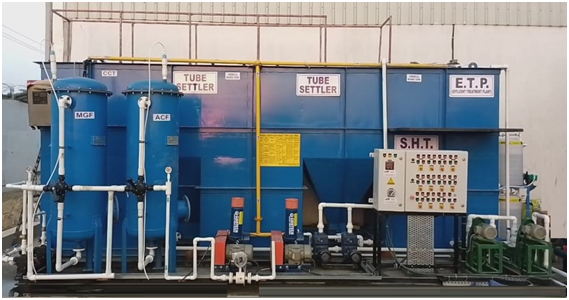Latest Developments in Effluent Treatment Plants (ETPs)

The following are some of the most effective and latest Effluent Treatment Technologies.
1. Advanced Oxidation Processes (AOPs)
For water purification and treatment, AOP helps in destruction of natural toxins, contaminants, organic pollutants, pharmaceutical residues, and other micropollutants which are very tough to remove through traditional methods. Powerful oxidizing reactors as hydroxyl or Sulphate radicals are used in AOP methods to degrade complex, toxic organics compounds into less harmful and non-toxic substances.
- Ozone Method: To get more greener way of treatment process, Ozone has been increasingly used in AOPs to oxidize contaminants rather than using harmful chemicals.
- UV-Hydrogen Peroxide: Combination of ultraviolet (UV) light and hydrogen peroxide is another best way for AOP that breaks down complex molecules into simpler, harmless compounds.
2. Membrane Technologies
Membrane technologies like Membrane Bioreactors (MBRs) and Nanofiltration (NF) are very popular with producing high-quality effluent in smarter way.
- Membrane Bioreactors (MBRs): Coupled with activated sludge reactor and membrane filtration unit, MBRs are used in municipal and industrial wastewater treatment plants. In this process, biologically active environment grows and consume all substances present in raw wastewater.
- Hybrid Forward Osmosis (FO) and Nanofiltration (NF): Design of hybrid forward FO-NF System is used in extraction of high-quality water with potential of less energy consumption and virtue of concentration difference through a semi-permeable membrane.
3. Zero Liquid Discharge (ZLD) Systems
Zero Liquid Discharge (ZLD) is very popular across various industries to minimize wastewater discharge and do complete water recycling.
- Evaporation and Crystallization: In this process, access water is evaporated in final phase of waste concentration. Coagulation, flocculation, ZLD System is useful in industries of power generation, textiles, and chemicals, where water-intensive processes produce large volumes of effluent.
- Electrodialysis: It is a membrane process that uses positive and negative charged ions to allow charged particles to flow through a semipermeable membrane and get high yield rare.
4. Bioaugmentation and Bioremediation
Biological treatment method uses addition of microbial biomass to affected area and improve biodegradation performance in less time.
- Enzyme-Based Treatment: This process involves usage of enzymes to degrade complex organic pollutants easily and without affecting nature.
- Microbial Consortia: For some specific sectors such as dye and textile manufacturing, customized microbial consortia are used to degrade dyes, heavy metals, and various complex chemicals.
5. Automation and Real-Time Monitoring
Why go for traditional methods in era of Digital technology and AI? Real time monitoring and automation of effluent treatment can be done through sensors, and data analytics. It results in live tracking of system and finding exact issue or root problems with calculative measures.
- Internet of Things (IoT) Sensors: Using this most advanced technology of IoT-enabled sensors, it is very easy to monitor crucial parameters for treatment process as pH, dissolved oxygen, chemical oxygen demand (COD), and biological oxygen demand (BOD) in real-time. Automated technology also helps in optimizing treatment process, practice consistent compliance and regulatory standards.
- Artificial Intelligence (AI) and Machine Learning (ML): With AI and ML models, it is easy to get future predictions of treatment needs and suitable process to implement. This technology also helps in identifying potential issues as equipment failure or changes in effluent composition.
6. Decentralized Effluent Treatment
There are many areas and systems where it is complex to set up a centralized ETP plant. For such places, decentralized ETPs are good to use. Its design is based on principle of installing system at source with limited infrastructure and ensured local water quality.
- Modular ETP Systems: Modular ETP Systems are very flexible and scalable solutions used across various industries. These are easy to install and maintain and make a budget-oriented solution for small and medium sized industries.
- On-Site Treatment: This system can be used on-site with ability to handle specific type of waste. With small operation cost and easy to use, it reduces burden of dependency on municipal treatment facilities and reduce total cost of disposal and transportation.
7. Energy Recovery from Wastewater
Energy efficiency and reduction of power wastage is key concern in effluent treatment. India is welcoming latest ETP technologies as biological process to recover and save energy from wastewater treatment process.
- Anaerobic Digestion: A best way of reducing Carbon footprint is Anaerobic process which is best application for not treating wastewater only, but also generate biogas, which can be used as an energy source to power the treatment plant itself.
- Microbial Fuel Cells (MFCs): A technology where metabolic activity of bacteria converts chemical energy into electricity during wastewater treatment. MFC technology is in demand as it generates electricity from the organic matter in wastewater.
8. Electrocoagulation
Electrocoagulation (EC) is latest ETP technology with use of less or zero chemical and resulting very effectively to remove dissolved solids, heavy metals, and other complex pollutants. Working method of EC system is passing electrical current to the wastewater which initiates coagulation of contaminants and easy separation of contaminants.
- Hybrid EC Systems: To give a pace to EC system, hybrid EC system comes up with integration of flotation or membrane filtration resulting to enhance overall treatment method effectively and reduce chemical usage.
9. Circular Economy and Resource Recovery
A way through which valuable resources can be recovered after water treatment process is demand of time. Biological and AI based technology are resulting to gain circular economy and recover resource in cost-effective way.
- Nutrients Recovery: This process can be used in agricultural and food processing effluent to recover essential nutrients as nitrogen and phosphorus to reproduce as fertilizers and crate a valuable resource for agriculture.
- Metals and Chemicals: Residue of some industries such as mining and electroplating are very hazardous for nature which urgently need feasible solutions. Using Advanced filtration technologies, industry can recover precious metals and chemicals from wastewater streams to get economic benefits as well as conform to pollution control laws.